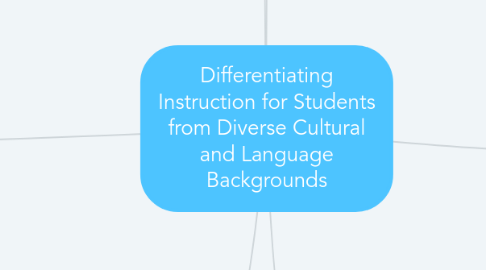Differentiating Instruction for Students from Diverse Cultural and Language Backgrounds
저자: Delanie Niemyer

1. Use Culturally Relevant and Responsive Teaching Strategies
1.1. Teaching strategies should be relevant and responsive to your students' experiences, cultural perspectives, language backgrounds, and developmental ages.
1.2. Teaching strategies should reflect and be aligned with students' cultural and linguistic backgrounds and learning preferences.
1.3. Effective teaching strategies: emphasizing verbal interactions, teaching students to use self-talk, facilitating divergent thinking, using small-group interaction, verve, focusing on real-world tasks, promoting teacher-student interactions.
2. Use Reciprocal Interaction Teaching Approaches
2.1. Use students' prior knowledge and experiences to add a context that promotes comprehension and incorporates language development and use.
2.2. Use student-centered teaching and dialogues, student-student interaction, problem-solving situations, and guided questions to help control learning.
2.3. Can use scaffolding. This when you break down comments and concepts that students do not understand or tasks that students have difficulty performing into smaller components.
3. Use Effectie English-as-a-Second Language and Dual Language Approaches and Techniques
3.1. Total physical response improves students vocabulary through modeling, repeated practice, and movement. Model the message by emphasizing physical gestures and objects.
3.2. Sheltered Instruction, or content-based instruction, uses cues, gestures, technology, manipulative, drama, and visual stimuli and aids to teach new vocabulary and concepts. Simplify vocabulary and grammar.
3.3. Help students develop language by using and promoting your students to use natural language techniques: expansion, expatiation, parallel talk, and self-talk.
4. Use Multicultural Curriculum
4.1. Multicultural curriculum should teach information about all groups and should be directed at all students.
4.2. Four hierarchical methods for incorporating multicultural information into the curriculum have been identified. The contributions approach, the additive approach, the transformation approach, and the social action approach.
4.3. Parallel lessons should be included. This allows students to learn about individuals and content from both the mainstream culture ad other cultures.
5. Use Multicultural Teaching Materials
5.1. Should reflect a wide range of experiences and aspirations.
5.2. Materials that reflect cultural, ethnic, linguistic, and gender diversity should be used frequently and should be fully integrated into the curriculum.
5.3. There are guidelines and questions that should be asked for evaluating multicultural teaching materials.
6. Encourage Students to Respond
6.1. Promote student responding by using open-ended questions, allowing students to use gestures, praising and expanding on contributions, and seeking more information when needed.
6.2. Give students enough time to interact with and discuss material before responding and encourage students to share their opinions and ask questions.
6.3. stimulate the use of language by providing experiences that encourage discussion such as introducing something new into the classroom.


